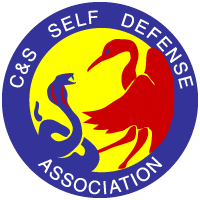
|
C&S Online
An Online Newsletter For The
C&S Self Defense Association
Spring 2003
Confidence. Fitness. Success.
|
|
Thoughts From The Board of Directors...
|

|

|
Alive & Kicking
Grandmaster Paul B. Dusenbery
|
|
Origins
In early February of this year,
I heard a remarkable talk by Dr. Donald Johanson on the discovery of the most famous skeleton ever uncovered. He is the director of the Institute of Human Origins. The skeleton was called Lucy, named after the Beatle’s song, “Lucy in the Sky with Diamonds” that was a favorite of the people who discovered her in Ethiopia in 1974. Lucy was found in the great rift valley of Eastern Africa. She lived about 3.2 million years ago. She was very tiny, some 4 feet high. Lucy is my ancestor. She is your ancestor. She lived at a time when humans where just getting going. Her people were foragers. Our ability to discover early humans is truly remarkable a mixture of good science and a bit of luck. These remains and many others that have been discovered provide an important window into our distant past. Based on what has been found to date, scientists can catch a glimpse of what life must have been like for these early species of homo sapiens. In fact all species of homo sapiens have died out except homo sapiens sapiens our species. We may never know what happened to all the other human species. Did the environment cause their demise or was it conflict or not enough intelligence to adapt to changing circumstances? Who knows? How humans came to be is one of the profound questions of our time. Another related question is the origin of life on Earth.
The Space Science Institute is developing a 3,000 square-foot traveling exhibition, called Cosmic Origins, which will bring origins-related research and discoveries to students and the American public. Cosmic Origins will have three interrelated exhibit areas: Star Birth, PlanetQuest, and Search for Life: Are We Alone? Exhibit visitors will explore the awesome events surrounding the birth of stars and planets; they will join scientists in the hunt for planets outside our solar system including those that may be in “habitable zones” around other stars; and finally they will be able to learn about the wide range of conditions for life on Earth and how scientists are looking for signs of life beyond Earth. Visitors will also learn about the tools scientists’ use, such as space-based and ground-based telescopes, to improve our understanding of the cosmos. SSI is joined by a number of great partners such as NASA space missions, the SETI Institute, and several museums.
The search for life beyond Earth and the study of the origins of life on Earth are some of the most exciting scientific explorations now underway. These studies require scientists who can cross many disciplines: astronomy, physics, geophysics, biology, and chemistry. Unraveling what is happening light years away in a star forming region or in a hydrothermal vent ecosystem 2,000 feet below the surface of the Atlantic Ocean is challenging and profound. One of the fascinating results we have found recently is the amazing diversity of life on this planet and that life can exploit every possible niche so long as there is some liquid water and an energy source. Life has been found in the hot springs of Yellowstone where very acidic water is close to boiling. Life has been found near deep sea vents far below the surface of the ocean where the pressures are enormous, where there is no sunlight and the organisms survive because extremely hot magma is oozing through cracks in Earth’s crust in regions called mid ocean ridges. Life is truly robust. Another amazing fact about life is that most life is found in single celled forms like bacteria. Glamour species (a term I heard first from shodan-ho Wally Van Sickle), like humans and tigers, form only a tiny fraction of the biomass of the planet. Simple life forms are what scientist are looking for on Mars and places like Jupiter’s moon Europa. Maybe someday Van Sickle can write about biodiversity and why it is important.
What does all this have to do with martial arts? Our Art is not afraid of tackling the difficult issues related to origins. An origins perspective provides a student with the ultimate context for discussing history, how people behave, and can lead one to a grand appreciation of Nature. We live in an amazing time. A time of great discoveries. A time of inconsistencies. It is an unsettling time for many. A time when there is great financial hardship around us. A time when we are at war. Neither you nor I can predict the future, but a deep study of the origins of our physical world, of our intellectual world, and our spiritual world can give us the necessary perspective to successfully navigate these challenging times.
Grandmaster Paul B. Dusenbery, PhD holds a 7th Degree Black belt. He began his studies with Grandmaster Rose in 1972. Dr. Dusenbery is a space scientist, writer, lecturer, and is the Executive Director of the Space Science Institute in Boulder, CO. He oversees the Dusenbery Tiger leg of C&S. Grandmaster Dusenbery can be reached at dusenbery@spacescience.org.
Top | Front Page | Board | Featured | Happenings | Views | Back Page | C&S Home
|

|

|
The Dragon's Tail
Senior Master David R. Landers
|
|
War And The Warrior's Way
First of all, let me say that,
no matter how you feel about this war or any other, let us all stand behind our troops who are putting themselves in harm's way for us. Again, regardless of you views on war, we, as martial artists study war for insight into battle on a personal basis. There are many strategic parallels to fighting against armies and fighting against individuals.
- Strike where you are not expected to strike. History is filled with surprise attacks that often turn the tide of war. Similarly, striking an opponent in an unprotected and unexpected area can be devastating to his defense. It never ceases to amaze me how even trained martial artists, in the heat of battle, go "head hunting". Consider that millions of years of inherited, hardwired through DNA, reactions that we all receive aimed at protecting our heads. Add to it the years of learning the hard way by bumping, being bumped, and scratched and struck, and our heads have a pretty well established defensive mechanism. Even a toddler throws his hands up to protect his face and head. In fact the very pervasiveness of this reaction to protect the head often leaves other areas less well guarded. Two good examples of this are the neck/throat and the short ribs. These areas, apart from being easier to hit, are also bad places to be hit.
- Once battle is engaged, follow through. One of the main failings of the Union Generals in the early years of the Civil War was the reluctance to follow up on victories and thus keep the South on the run. Grant changed all that. Grant would even follow what would seem to be a defeat with an attack. Many street fights are lost due to one party gaining a temporary advantage and slacking off his attack. Notice I said "attack". If you know me, you know there is no "defense". Relinquishing momentum, even for an instant, invites opportunity for lucky shots, slips, added attackers, and other imponderables. When you gettem' on the ropes, keepem' there.
- In keeping with number 2, faster is better. From the time hostilities break out, until the time to strike, should be as brief as possible. Just as you don't want soldiers waiting long periods of time anticipating action and giving morale a chance to wane, you don't want to argue and posture with potential opponents until your adrenaline comes and goes. Go in quick and go in hard. Injuries that you may sustain will not be nearly as painful or debilitating if you are moving too fast to give much notice.
- Watch your flanks. In history we see many examples of flanking attacks used with great success. Armies, like individuals, can develop tunnel vision. While I advocate straight ahead, hard charging, I also urge you to be aware of your surroundings. Remember, keeping your head, and gaze, down gives a broader field of vision, taking in more of the battlefield.
- Win! Winning is as much a product of attitude and perception than it is of tactics. Winners will win almost regardless of what weapons or conditions are present, and losers will manage to loose regardless of real advantage. Martial arts present you with a way to become winners. You have already engaged the most tenacious opponent you will ever face….yourself.
Master David R. Landers holds a 6th Degree Black belt. He began his studies with Grandmaster Rose in 1969. He served as Deputy Chief of Police of Effingham, Illinois from 1997 to 2000 when he assumed the role of Illinois State Field Coordinator for the Midstates Organized Crime Information Center. He oversees the Landers Dragon leg of C&S. Master Landers can be reached at candsdragon@mchsi.com.
Top | Front Page | Board | Featured | Happenings | Views | Back Page | C&S Home
|
Website design by Peter Rose, zzrose@yahoo.com
|


